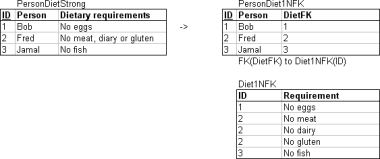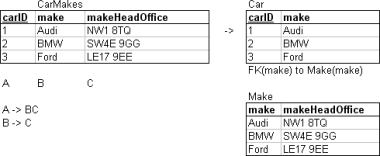3.2. Normal Forms
In this lecture we look at...
[Section notes PDF 121Kb]
3.2.01. Orthogonal design
- Information Principle:
- The entire information content of the database is represented in one and only one way, namely as explicit values in column positions in tables
- Implies that two relations cannot have the same meaning
- unless they explicitly have the same design/attributes (including name)
3.2.02. Normalization
- Reduced redundancy
- Organised data efficiently
- Improves data consistency
- Reduces chance of update anomalies
- Data duplicated, then updated in only one location
- Only duplicate primary key
- All non-key data stored only once
- Data spread across multiple tables, instead of one Universal relation R
3.2.03. Good or bad?
- Depends on Application
- OLTP (Transaction processing)
- Lots of small transactions
- Need to execute updates quickly
- OLAP (Analytical processing/DSS)
- Largely Read-only
- Redundant data copies facilitate Business Intellegence applications, e.g. star schema (later)
- 3NF considered ‘normalised’
- save special cases
3.2.04. Normal forms (1NF)
- First Normal form (1NF)
- Disallows multivalued attributes
- Part of the basic relational model
- Domain must include only atomic values
- simple, indivisible
- Value of attribute-tuple in extension of schema
- t[Ai] ∈ (Ai)
3.2.05. Normalisation (1NF)
- Remove fields containing comma separated lists
- Multi-valued attribute (AMV) of Ri
- Create new relation (RNEW)
- with FK to Ri[PK]
- RNEW(UID, AMV, FKI)
3.2.07. Normal forms (2NF)
- A relation Ri is in 2NF if:
- Every nonprime attribute A in Ri is
- fully functionally dependent on 1y key of R
- If all keys are singletons, guaranteed
- If Ri has composite key are
- all non-key attributes fully functionally dependent
- on all attributes of composite key?
3.2.08. Normal forms (2NF)
- Second normal form (2NF)
- Full functional dependency X → Y
- A ∈ X, (X - {A}) ¬→ Y
- If any attribute A is removed from X
- Then X → Y no longer holds
- Partial functional dependency
- A ∈ X, (X - {A}) → Y
3.2.09. Normal forms (2NF)
- In context
- Not 2NF: AB → C, A → C
- AB → C is not in 2NF, because B can be removed
- Not 2NF: AB → CDE, B → DE
- because attributes D&E are dependent on part of the composite key (B of AB), not all of it
3.2.10. Normalisation (2NF)
3.2.11. Normal forms (BCNF)
- Boyce-Codd Normal form (BCNF)
- Simpler, stricter 3NF
- BCNF → 3NF
- 3NF does not imply BCNF
- nontrivial functional dependency X → Y
- Then X must be a superkey
3.2.12. Normal forms (3NF)
- Third Normal form (3NF)
- Derived/based on transitive dependency
- For all nontrivial functional dependencies
X → A - Either X must be a superkey
- Or A is a prime attribute
(member of a key)
3.2.13. Normal forms in context
- AB → C, C → D, D → A
- In context
- 3NF? Yes
- Because AB is a superkey and
- D and A are prime attributes
- BCNF? No
- Because C and D are not superkeys
- (even though AB is)



